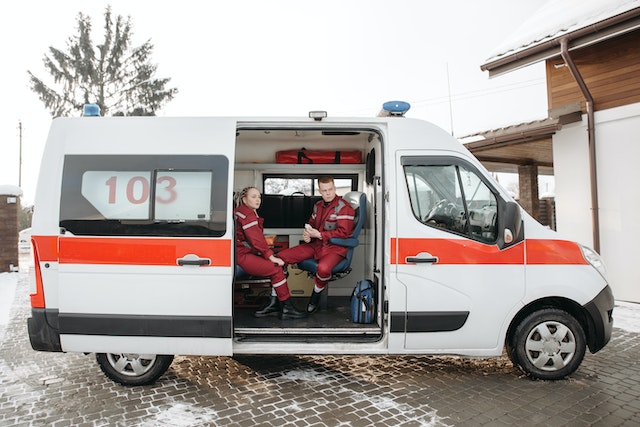Whether it’s an emergency or non-emergency situation, sometimes, you can’t avoid a trip to a medical facility. You must contact an ambulance service to assist you in these situations. So, should you call a public or private ambulance service?
Discover the differences between public and private medical transport services and their pros and cons.
What Is a Private Ambulance Service?
Private ambulance services are usually under the ownership of a non-governmental organization. Since individuals own them, their features are more flexible. The prices are higher, but they’re usually much more convenient than public ambulance services.
They also have skilled medical professionals, including paramedics and EMTs, ensuring you receive the necessary care during transit.
In everyday situations, these services prove invaluable. Imagine a scenario where you or a loved one sustains an injury in an accident, requiring immediate transportation to the hospital. Private ambulance services step in promptly, providing swift and efficient transport to help you reach medical care without delay.
One thing, however, about private ambulances is that you’ll have to handle the cost of booking and the services they provide yourself. Although your health insurance plan might cover the costs, you’ll still have to pay part of it out of pocket.
Pros of a Private Ambulance Service
Here are reasons why you should consider a private ambulance service:
- Readily available and accessible: Most times, public ambulance services are only available for emergencies. So, a private ambulance service comes in really handy in non-emergency situations.
- No restrictions to location or hospitals: Private emergency vehicle services are your only option if you want to receive treatment from a hospital outside the service area of a public ambulance service. They allow you to choose the medical facility you prefer, even if it’s out of town.
- Private ambulances are more accommodating: A private ambulance is more likely to accommodate your specific needs than a public ambulance. They’ll provide you with facilities and professionals like EMTs or paramedics who can accompany you anywhere you need medical care. Also, these professionals give you the assistance you need while en route to the hospital.
- Provision of ambulance service during gatherings and events: Some organizations require ambulances to be on standby during certain events like sports festivals and concerts. In these cases, public ambulances may be unable to provide the needed services. However, private ambulances are very flexible, and you can schedule their services for such events.
- Convenience and comfort: Generally, private medical transport is more convenient and comfortable than public ambulances. In a private ambulance, you’ll have access to the best facility and equipment to make your trip to the hospital comfortable. You can also schedule these trips for when you need them.
Cons of a Private Ambulance Service
While private ambulance service may seem all positive and your best choice, it isn’t without some drawbacks. They include:
- High cost of service: The cost of private medical transport services is higher, and you’ll have to pay for them yourself. Also, some private ambulances charge per mile and increase your bill based on distance.
- Limited regulation: When it comes to private ambulance services, there might be less oversight compared to public services. This lack of regulation could impact the quality and safety of the care provided.
- Questionable reliability: Private ambulance services might not be as dependable as their public counterparts. In emergency situations, reliability is crucial. Private services may not always deliver the same level of prompt and consistent response.
- Insurance uncertainty: It’s important to note that insurance coverage for private medical transport can vary widely. Some insurance plans may cover these services, but others might not. This can leave you uncertain about whether their emergency transport costs will be under coverage. Also, this uncertainty can create financial stress during already challenging times.
Public Ambulance Services
Public ambulances usually operate under the laws of the state. They’re provided and funded by the government, and in some states, they’re partly financed by taxes.
They often assist in medical emergencies within a specified jurisdiction. This means public ambulance services hardly ever operate outside of their specified area.
There are some limitations to the services public ambulances provide. So, despite their cheap costs, you should request a private ambulance service if you want specific care options during transit.
Pros of Public Ambulance Services
Here is why you should consider public ambulance services:
- Lower cost: Most of the fees required by public ambulance services are handled by the state, leaving you with only a token or nothing to pay.
- Timely services: Public ambulances are provided at specific locations throughout every state. If you need urgent medical assistance, a public ambulance may reach you faster than a private ambulance.
Cons of Public Ambulance Services
While public ambulance services may be good and affordable, they also have some drawbacks compared to private ambulance services:
- Restriction to a particular area: Public ambulances serve specific geographic regions and can only transport patients to the nearest hospitals. They typically don’t allow you to choose which hospital or healthcare facility you want to go to.
- Rigid rules and specifications: Public ambulances obey the regulations of the state. So, it’s usually difficult for them to bend the rules to your favor or change the specifics of their operations.

What Are Emergency and Non-emergency Cases?
Ambulance services offer transportation to patients in a state of emergency. They also cater to people whose needs aren’t urgent but still need a ride to a medical facility. This means that patients without emergencies can schedule ambulance trips.
Examples of Emergency Cases
- Road traffic accidents
- Falling from a height
- Burns and fire accidents
- Drowning
- Gunshot wounds
- Severe allergic reaction
- Severe vomiting and diarrhea
- Poisoning by chemicals or toxins
- Dislocation or bone injuries
- Asthma attacks
- Sudden collapse
- Severe bleeding
- Severe head injuries
- Difficulty in breathing or choking
Generally, any condition that puts the patient in a critical state is an emergency.
Examples of Non-emergency Cases
- Doctor appointments
- Wound dressings
- Slight abdominal discomfort
- Mild fever and headache
- Body pains
- Constipation or diarrhea
- Mild cuts or bruises
- Post-surgical checkups
- Kidney dialysis sessions
- Differences Between a Private and Public Ambulance Service?
The most common difference between public and private ambulance services is in convenience and costs. Private ambulance services offer more comfort than public ambulance services and are more expensive.
While a public medical transport service operates within a specific area, a private medical transport service isn’t restricted to one location. Public ambulance services are primarily available for emergency cases, while you can schedule private ambulance services for non-emergency trips to the hospital.
For example, if you or a loved one needs to get to a kidney dialysis session, booking a private ambulance service is your best bet. A private ambulance service will help you get to and from any hospital you need to go, even if it’s far away. You’ll also have medical professionals to accompany you in case if you need any medical attention in transit.

Cost of a Private Ambulance Service
Private ambulances offer services ranging from transportation, nurse and emergency personnel provision, oxygenation, complex medical care, etc., en route to the hospital.
After every trip, a private ambulance company will provide you with a bill that details the services you received and the cost. On average, the total cost of a trip can range from $400 to $1,200 or more depending on whether you have insurance, how many miles you travel, whether you need basic or advanced life support, etc.
Book Elite Private Ambulance Service
Ambulances aren’t just for emergencies. And you may not have access to a public ambulance service if it’s not an emergency.
At Elite Ambulance, we offer emergency and non-emergency transportation to medical facilities. We’ve emerged as one of the best ambulance service providers in Chicago. So, you can rest assured that you’ll receive elite care from us at affordable rates.
Comments are closed.



Recent Comments